You are here:
- CMP Home >
- Web Exhibits >
- Stereoscopic Images >
- Cleveland
- SUBJECT:
- COMPANY:
- GEOGRAPHIC LOCATION
Stereoscopic Images of Cleveland in 3-D
Cleveland
- This gallery contains 16 slides. Click on the arrows to advance to the next or previous slide.
- Click on the the photo to see the 3-D rendering.
- To view the total effect of the 3-D versions of the images use anaglyph 3-D Glasses (red/cyan).
-

Traffic in Public Square and Euclid Avenue, Cleveland, Ohio
We are in the very heart of Cleveland, county seat of Cuyahoga County, and fifth city in size in the United State. From the Public Square before us, with its great Soldiers' and Sailors' Monument and statue of General Cleveland (sic), radiate the principal streets of the east side of the city, and to this Square converge the principal trolley lines. Here begins the famous Euclid Avenue, for some distance occupied by business houses, but farther out a handsome residential district, shaded by elms and maples and lined with palatial private homes surrounded by spacious grounds and gardens. The skyline of the business section of the city is broken by huge skyscrapers and by large department stores. The City Hall, Post Office, Chamber of Commerce and other public buildings, as well as fine hotels which provide every convenience an comfort are nearby. in the residential sections, remote from the roar of traffic, are to be found luxurious apartment houses, handsome churches, numerous parks an gardens and broads, well-lighted, attractive drives. The situation of Cleveland, on the southern shore of Lake Erie, near the iron producing regions of the Great Lakes on the one hand and the oil and coal of Pennsylvania on the other , ahas greatly favored the industrial and commercial development of the city. Some of the leading trunk lines of the railway system on the country pass through Cleveland, and there is an immense lake traffic. Many of the ore docks and lumber yards are almost hidden on the flat land bordering the Cuyahoga river, which empties into the lake. -

An Air View of Downtown Cleveland — the Public Square, the Terminal Tower and the Winding Cuyahoga
The Heart of Downtown Cleveland From The Air: The situation of Cleveland on the shore of Lake Erie, near the iron producing regions of the Great Lakes on the one hand and the oil and coal of Pennsylvania on the other, has greatly favored its industrial and commercial development. From an airplane fourteen hundred feet in the air we are looking down over the very heart of Cleveland. The park-like area in the immediate foreground is its famous Public Square which was laid out by Moses Cleveland (sic) in 1796. The wide street running through the center is Superior Avenue. The dominating structure in the scene beneath us is the tower of the Union Passenger Terminal, one of the finest railway terminals in the world. Here has been developed the nucleus of a small city in an area of about thirty-give acres. The Terminal Building group is a one hundred million dollar development and consists of a bank, a hotel. , a department store, a Medical Arts Building, and a Builders Exchange Building in addition to the Terminal Tower Building. The Tower soars to a height of 708 feet above e the concourse level. In the background is the Cuyahoga River that flows in winding, crooked S's through Cleveland's downtown industrial area before it finds its outlet in Lake Erie. Along the river are situated many of Cleveland's large iron and steel plants as well as many of the docks that accommodate a great share of its lake shipping. Owning to the variation in level of different parts of Cleveland there are several elevated viaducts and many bridges, nearly all municipally owned, that span the Cuyahoga River and unite the different sections of the city. Some of these are seen in the background. -

Water Works
No accompanying text. -
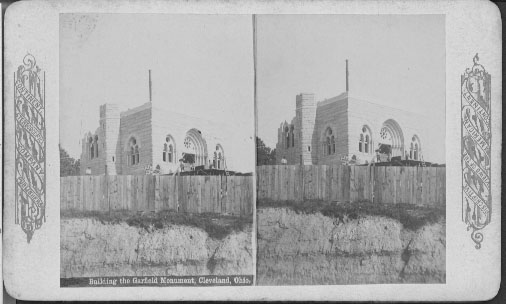
Building the Garfield Monument, Cleveland, Ohio
Written on back in pen: "Dr. Paulina Morton," "C.F.K." and "July 24th to Aug. 10th, 1886." -

Superior Street, Cleveland, Ohio
No accompanying text. -
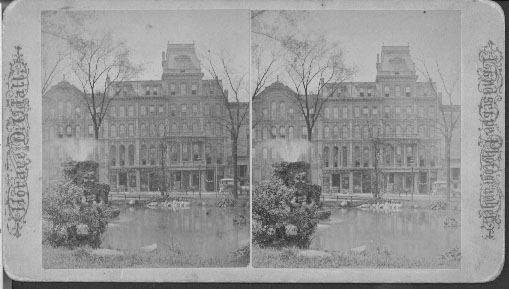
Rustic Fountain and Forest City House:
No accompanying text. -

Looking Up the River, Cuyahoga Falls, O.
No accompanying text. -

Rocky River
No accompanying text. -
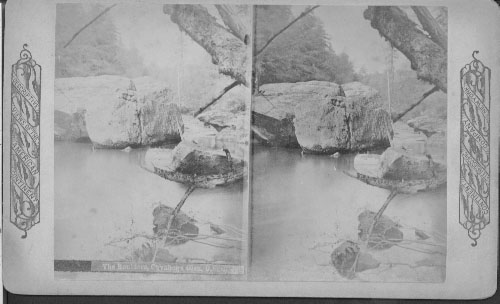
The Boulders, Cuyahoga Glen, O.
No accompanying text. -
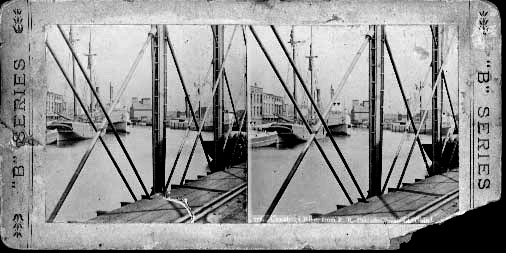
Cuyahoga River, from R.R. Bridge, Cleveland, Ohio
No accompanying text. -
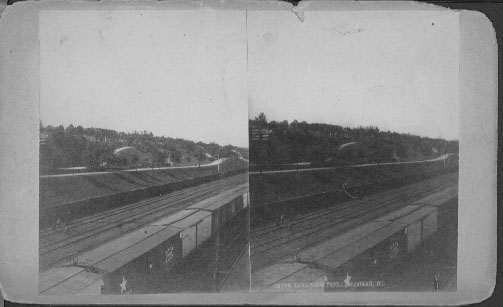
Lake View Park
No accompanying text. -
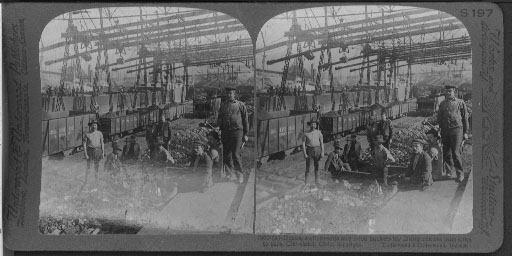
Docks, switchyards and 1-ton buckets for lifting iron ore from ships to cars, Cleveland, Ohio.
We are looking north, i.e., towards Lake Erie, over the great ore docks along the "Old River Bed" canal. Here immense quantities of iron from the Lake Superior mines are transferred to trains and shipped to the famous blast furnaces and steel-mills at Youngstown, Pittsburgh and elsewhere in the Ohio river valley, 100 to 150 miles away at the southeast. The partially crushed ore in the cars here at our feet and that soft, earth-like ore in the cars beyond have both come up from near the head of Lake Superior where the biggest and richest iron mines in the whole world are being worked. The hoisting apparatus overhead makes quick work of unloading a freighter, for those suspended buckets hold a ton apiece. They are run out over a vessel, let down into the hold, filled, drawn up, slid across the intervening space and then lowered for dumping into a car, all in a space of time hardly more than it takes to tell about it. If the supply of empty cars is insufficient, the accumulating surplus forms great stock-piles like those straight ahead, at our right. Still more rapid work can be done with immense "clams" that clutch five or ten tons at once; the gigantic steel derricks of such an unloading plant loom up in the distance at our left. We can watch at short rang the operation of such powerful machines by using Stereographs 7963 or 7970. For the mining of this ore, use 7947 and 7954. For its later manufacture into steel, use 5520-5523. From Notes of Travel No. 37, copyright by Underwood & Underwood ("Docks at Cleveland, O., with apparatus for unloading iron ore" is written in six languages, including English, French, German and Russian.) -

Unidentified Rails.
No accompanying text. -

Trains at Cleveland, from Lake View Park
No accompanying text -
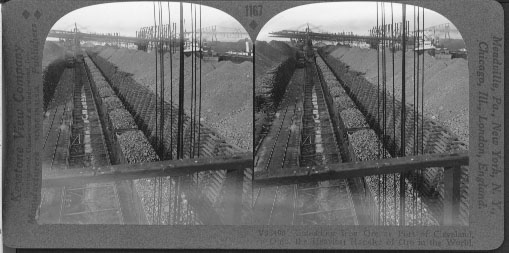
Unloading Iron Ore at Port of Cleveland, Ohio, the Heaviest handler of Ore in the World.
Iron Ore at the Port of Cleveland: Going westward from downtown Cleveland, we pass over the famous High Level Bridge and Bulkley Boulevard. In going through this part of the city sights such as this are common for many of Cleveland's ore docks and lumber yards are almost hidden on the flat land bordering the Cuyahoga River which empties into Lake Erie. A visit to Cleveland's waterfront is a fascinating adventure. Here we are looking north toward the lake. The steamers we see in the distance have come from the iron county in the vicinity of the western end of Lake Superior, where are located some of the richest iron mines in the world. To the port of Cleveland is brought over 4,000,000 tons of iron ore every year. Those long lines of piles on either side are some of this ore. Those gigantic arms in the distance that reach out over the railway tracks are part of the huge unloading machinery by which means the ore in all these piles has been taken out of the holds of the ships and dumped here. Notice the coal in the long line of freight cars. This coal is to go back to the iron county in the steamer that brought over the ore. These cars will be sent to a coal dock. As soon as the ore boat is unloaded, it will go to the coal dock and be loaded with coal. In turn the ore will be loaded into these cars after they are emptied and thus will reach the iron-manufacturing center where it will be transformed into steel. The steel eventually may reach Africa as a steel rail for a railway track, or Asia as bridge material that will span a Himalayan mountain gorge. -
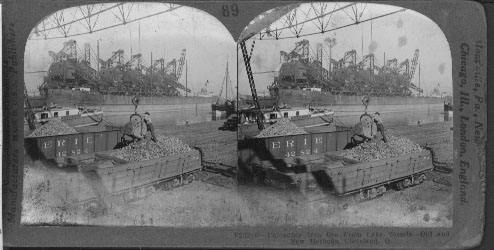
Unloading Iron Ore From Lake Vessels-Old and New Methods, Cleveland, O.
Cleveland is the largest city in the state of Ohio, and it situated on the south shore of Lake Erie at the mouth of the Cuyahoga River. It had excellent connection by water with Superior iron regions. It has a lake frontage of about fourteen miles, protected for five and three-quarter miles by a breakwater constructed by the Federal Government. The harbor has unexcelled facilities for handling iron ore. That lake steamer over yonder and the nearer vessel at our left have come down from the western end of Lake Superior, laden with ore for great steel mills at Youngstown, Pittsburg, or Wheeling.
A few years ago the unloading system which we see in operation directly before us was considered splendidly effective. That suspended bucket has been lowered into the vessel's hold and there filled, then drawn along an overhead trolley beam for dumping into the car.
Today the "clam" unloaders are more commonly used. We can see this apparatus looming in the air above that farther pier. By this newer method, five to ten tons of ore can be lifted in one load, and the work can be done much more quickly than by the "pocket" method.



